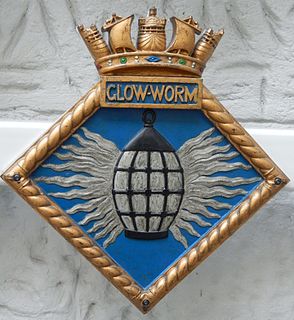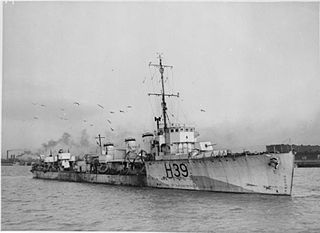Related Research Articles
Eight ships of the Royal Navy have been named HMS Ardent, whilst another two were planned:
Eight ships of the Royal Navy have borne the name HMS Centaur, after the half-human, half-horse centaur of Greek mythology:
Three vessels of the Royal Navy have been named HMS Salmon after the fish:

Three ships of the Royal Navy have borne the name HMS Glowworm after the insect, whilst two more were planned:
Four Royal Navy ships have been named HMS Grenville. Vice Admiral Sir Richard Grenville was an Elizabethan sailor, explorer, and soldier:
Three ships of the Royal Navy have been called HMS Raider.
Seven ships of the Royal Navy have been named HMS Orpheus. Orpheus was the magical father of songs in Greek mythology.

The first R class were a class of 62 destroyers built between 1916 and 1917 for the Royal Navy. They were an improvement, specifically in the area of fuel economy, of the earlier Admiralty M-class destroyers. The most important difference was that the Admiralty R class had two shafts and geared turbines, compared with the three shafts and direct turbines of the Admiralty M class, but in appearance the R class could be distinguished from its predecessors by having the after 4-inch gun mounted in a bandstand. The Admiralty ordered the first two of this class of ships in May 1915. Another seventeen were ordered in July 1915, a further eight in December 1915, and a final twenty-three in March 1916.
Three ships of the Royal Navy have been named HMS Onslow:
Several ships of the British Royal Navy have been named HMS Partridge, after the bird.
Nine ships of the Royal Navy have borne the name HMS Ariel, possibly after the archangel Ariel in Judeo-Christian mysticism, but certainly influenced by Shakespeare's "airy spirit" of the same name:
Three ships of the Royal Navy have borne the name HMS Starfish, after the Starfish, a marine creature:
Seven ships of the Royal Navy have borne the name HMS Recruit:
Three vessels of the British Royal Navy have been named HMS Nerissa:
Two ships of the Royal Navy have been named HMS Obdurate:
There have been two ships of the Royal Navy named HMS Rosalind, named after the protagonist in William Shakespeare's As You Like It:
At least three ships of the Royal Navy have borne the name HMS Sarpedon. They are named after Sarpedon, a Greek hero and son of Zeus.
There have been three ships of the Royal Navy named HMS Redgauntlet after the novel by Sir Walter Scott:

HMS Sable was a R-class destroyer that served with the Royal Navy during the First World War. The R class were an improvement on the previous M class with geared steam turbines to improve efficiency. Laid down by J. Samuel White at East Cowes on the Isle of Wight, the destroyer was launched in November 1916 and joined the Grand Fleet. Service during the war was mostly uneventful, apart from a collision with fellow R class destroyer Salmon. After the War, the destroyer was placed in reserve and decommissioned, being sold to be broken up in August 1927. In a twist of fate,Salmon was renamed Sable in 1933.
Six vessels of the Royal Navy have been named HMS Sylph after the air spirits known as sylphs:
References
- Colledge, J. J.; Warlow, Ben (2006) [1969]. Ships of the Royal Navy: The Complete Record of all Fighting Ships of the Royal Navy (Rev. ed.). London: Chatham Publishing. ISBN 978-1-86176-281-8.